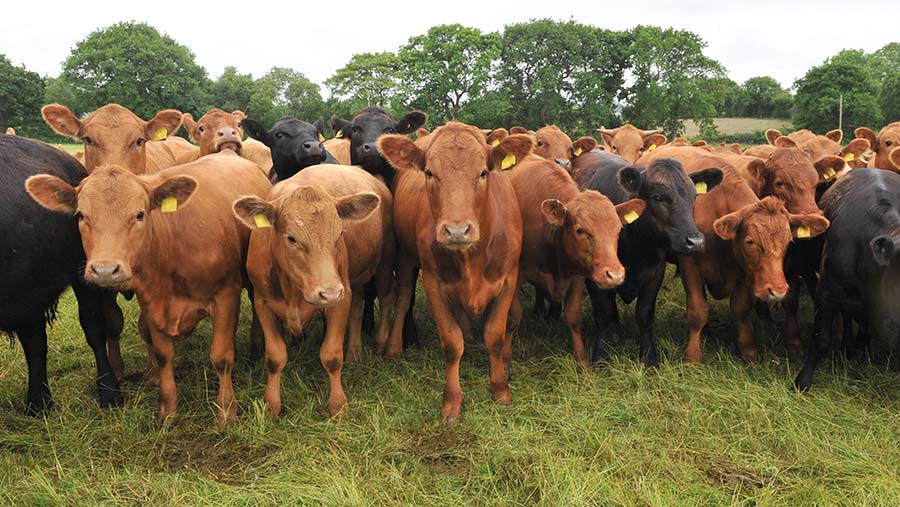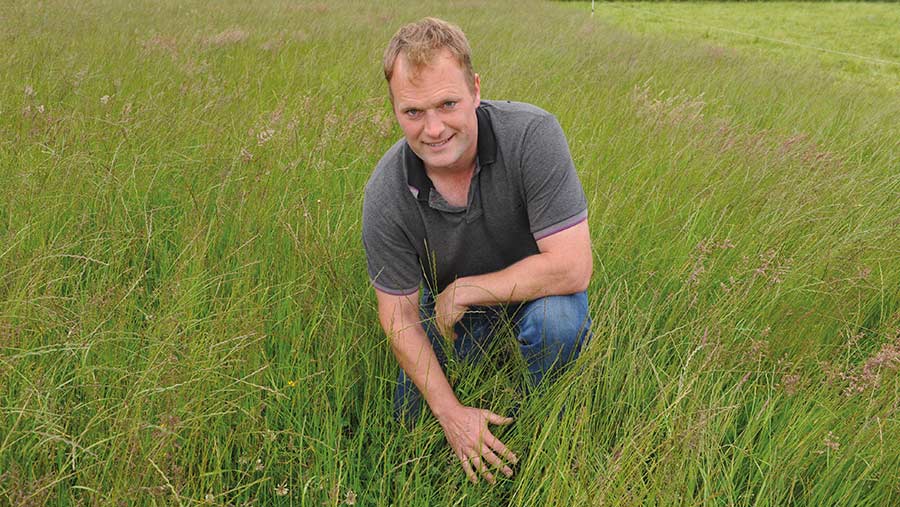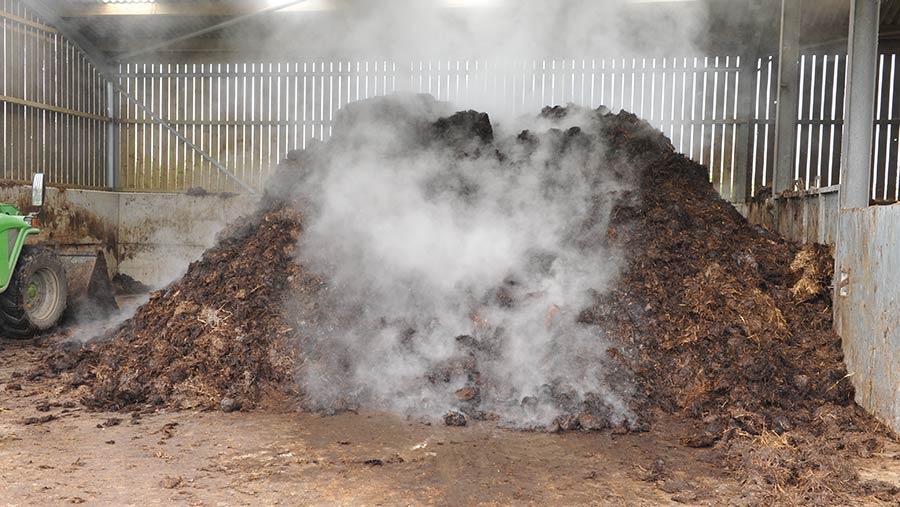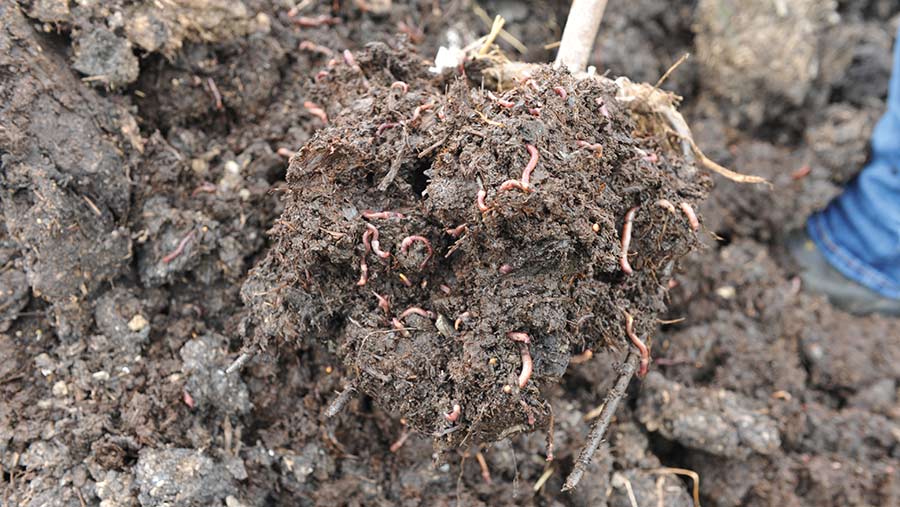How grazing change can help soil health and resilience
 © Debbie James
© Debbie James Farming using regenerative principles is helping the Cowcher family reduce costs and build resilience on their organic beef and sheep farm.
Intensive rotational grazing over several years had produced positive results at Penrhiw Farm, near Llandysul. But switching to a system of higher grass covers, using a high stocking density, seemed like the next area of potential gains, says Phil Cowcher, who farms with his parents, Tom and Eva, and sister, Nia.
Although the farm has a higher-than-average annual rainfall, shallow, stony soils result in fields burning off quickly in a dry spell.
See also: Beef grazing project benefits soils and biodiversity
Grazing rotations had been managed tightly, with target entry covers of about 2,500kg dry matter (DM)/ha for sheep, 2,800kg DM/ha for cattle and grazing residuals of 1,500kg DM/ha.
“This worked fine while growing conditions were favourable, but left very little buffer during dry periods,” says Mr Cowcher.
An attempt to improve resilience triggered a further shift to regenerative farming principles, with minimum soil disturbance and a change of grazing regime.
Farm facts
- 182ha (450 acres), farmed organically since 2001
- 900 Highlander, EasyDam and Easycare ewes and ewe lambs
- 70 Stabiliser cows
- Lambs sold to Dunbia at 18kg average deadweight
- Cattle sold at 18-24 months to ABP
Grazing density
High-density grazing, with entry covers of 2,800-4,500kg DM/ha and longer grass recovery periods, now sees stock removed from fields when residuals are 1,600-2,500kg DM/ha, depending on the time of the year and class of stock.
By sub-dividing paddocks, they are grazed at a stocking density of more than 50,000kg liveweight/ha. At that density, the stock graze less selectively.

Phil Cowcher © Debbie James
“They graze it to a higher residual much more evenly and that allows quality to be maintained for the following round, while ensuring rapid regrowth,” Mr Cowcher explains.
“When we were taking it down to 1,500kg DM/ha there wasn’t enough left for the grass to get going again.’’
Rest periods
Fields are rested for 30-50 days during the main growing season, and for up to 150 days during winter, before regrazing.
The result is a higher volume of grass across the farm. “We have so much grass in front of the cattle and sheep that we can easily go more days than we did without running short.
“There is more of a buffer, and that makes everything much less stressful,” says Mr Cowcher.
The aim is to graze grass only once it has fully recovered. This is when there are at least three pointy leaves on a ryegrass plant, he says.
“We usually aim to graze while grass is leafy, to maintain quality.
“However, we do sometimes graze more mature grass with cattle, to draw out their rotation, or act as a buffer during dry periods, before going back into leafy pasture once grass growth recovers.”
Species diversity
Growing the grass longer makes it deeper rooting and that has improved soil biology, he adds. Species diversity is also improving, with species such as red clover, white clover and bird’s-foot trefoil appearing from the natural seed bank.
To regenerate poorer-performing fields, Mr Cowcher overseeds with diverse seed mixes. These are sown in front of the stock using a quad and a spinner, and the stock tread the seed in.
Cocksfoot is particularly useful because it suits the land at Penrhiw and it responds well to grazing.
Grazing management
There have also been changes to the way cattle and sheep are grazed.
After weaning, lambs are grazed on white clover with high covers and are followed by cows and calves in a leader-follower system.
It helps to keep the growth rates up in the lambs, says Mr Cowcher.
“We had seen a reduction in individual weights since intensifying the grazing, although overall we were producing more kilograms of lamb a hectare.
“By using a leader-follower system, we have seen individual weights improve to what they were previously, while maintaining higher kilograms of lamb a hectare.”
Lambs are also integrated with cattle to reduce worm burdens, aiming where possible to alternate sheep and cattle in each grazing round to break parasite cycles.
“We tried grazing them together, which did work fairly well, but it can be a bit disruptive for the lambs.
“So, we now swap them around until weaning and have slightly lower covers for the sheep by having a shorter rest period from cattle to sheep,” Mr Cowcher explains.
All decisions revolve around the goal of improving soil health, including how farmyard manure is managed.
Composting manure
Muck is stored in the sheds and turned with a telehandler during the composting phase. This keeps it within the correct temperature range to produce an aerobic compost.
Once it has cooled and allowed to mature, it is spread on the pasture following grazing or cutting for silage.

© Debbie James
As an experiment, Mr Cowcher has created a heap of vermicompost by introducing specific breeds of composting earthworms – a mix of “red wigglers” and tiger worms – to composted manure.
The worms ingest the manure, then excrete casts, which form a soil conditioner and biological stimulant. This is then spread as a thin layer on poorer-performing fields.
“It is a good product for the soil – it has a better balance of bacteria and fungi than standard muck and stimulates soil life,” says Mr Cowcher.
The next step will be to mix small amounts of sieved vermicompost into seed mixtures before overseeding, to aid germination.

© Debbie James
Finishing on forage
The farm has changed from a system of feeding home-grown grain to ewes and finishing cattle to a forage-only system.
Ewes are grazed a month before lambing on a pre-lambing rotation.
Calves are weaned outdoors, and the winter period has been reduced, while finishing cattle are either finished off grass by 18 months, or indoors on silage during winter at up to 24 months.
“It cuts out the need to grow our own grain and that takes away the need to plough,” says Mr Cowcher.
Cost benefit
Although the shift to regenerative farming has been positive for the farm, there are some drawbacks. These include the investment required in fencing and water infrastructure, along with the labour needed for managing grazing.
“I spend more time setting up fences – there is a lot more subdivision, and I try to move stock at least once a day and every three days on the off-lying rented land,” he says.
“We try to have fewer, but larger, groups, which helps improves efficiency and grazing pressure.”
But that is more than compensated for by cost reductions in other areas of the business, including cultivation, feed and fuel.
“It is very satisfying to see the pasture developing year on year just from management and it is much less stressful because we have a feed buffer in a dry spell,” says Mr Cowcher.
